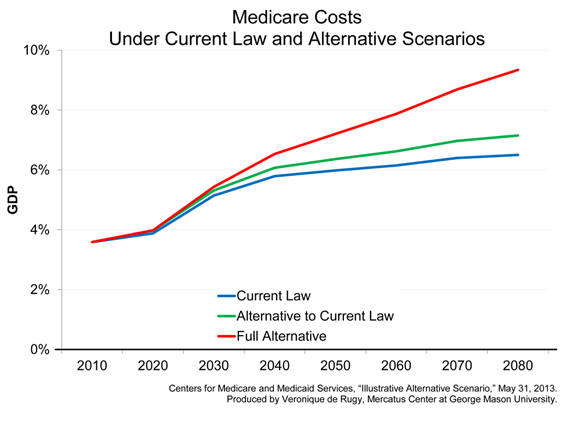- | Government Spending Government Spending
- | Data Visualizations Data Visualizations
- |
2013 Cost Projections for Medicare Programs
The cost projections for Medicare programs outlined in the 2013 Trustees’ Report rely on unrealistic assumptions regarding current laws (e.g., Affordable Care Act and Medicare physician fee payments), cost-savings, and higher revenue. There is little reason to expect these cost-reduction aspects of the law to materialize.
The cost projections for Medicare programs outlined in the 2013 Trustees’ Report rely on unrealistic assumptions regarding current laws (e.g., Affordable Care Act and Medicare physician fee payments), cost-savings, and higher revenue. There is little reason to expect these cost-reduction aspects of the law to materialize.
Social Security and Medicare Public Trustee Charles Blahous explains why Medicare costs almost certainly will be higher than current law projections in the 2013 Trustees’ Report:
Like other federal scorekeepers, the trustees are required to project program operations under current law regardless of whether most people assume that current law will be sustained. This is particularly important with respect to Medicare projections because current law specifies that physician payments will be cut by nearly 25 percent in early 2014 under the statutory Sustainable Growth Rate (SGR) formula. Lawmakers have overridden similar payment reductions in every year since 2003 and are widely expected to do so again.
This week’s charts compare the Medicare cost projections under current law assumption with more realistic alternative assumptions measured as a percentage of the economy. The Medicare Trustees’ Report presents an illustrative alternative scenario that assumes a continuation of the historical pattern of SGR overrides; the report also shows an another alternative scenario in which, in addition to an SGR override, certain controversial elements of the 2010 Affordable Care Act (ACA) are either scaled back during the period from 2020 to 2034 or eliminated altogether.
Under the first alternative scenario, total Medicare costs will be 7.2 percent of GDP in 2087, as opposed to 6.5 percent under current law. In the second alternative scenario, total Medicare costs climb to 9.34 percent of GDP by 2087. If lawmakers continue to override the physician payment formula, total Medicare costs will be substantially higher than what we now project in the long run, more than 10 percent higher. Medicare expenditures in 2080 could be about 45 percent greater than projected under current law.
Under current law, Hospital Insurance (HI) costs are projected to increase to 2.56 percent of GDP in 2080, or roughly 55 percent greater than their 2012 level. Under the illustrative alternative to current law, costs would be 3.87 percent of GDP in 2080, or roughly 135 percent greater than their 2012 level.
Under current law, Part B spending is projected to increase from 1.48 percent of GDP in 2010 to 1.65 percent by 2020 and 2.56 percent of GDP by 2080. For the alternative physician projection, Part B grows to 1.75 percent of GDP in 2020 and 3.21 percent of GDP by 2080. In the full alternative scenario, Part B is expected to increase more rapidly, reaching 4.09 percent of GDP by 2080.
Even these grim numbers may be too optimistic because some of the expected revenue or cost savings in the current law may never materialize, as a section at the end of the Trustees’ Report (p. 273), called “Statement of Actuarial Opinion,” makes clear. Paul Spitalinic, the acting chief actuary of the program, explains that “current law would require a physician fee reduction of an estimated 24.7 percent on January 1, 2014 — an implausible expectation.”
Regardless of which scenario plays out, rising Medicare costs threaten our economic health. Doing nothing is not a wise option.
Data note: It is customary to express long-range costs of Medicare, HI and Part B programs as a percentage of GDP to facilitate interpretation and comparison of costs over such distant period. The listed data findings are taken from the 2013 Trustees’ Report.




